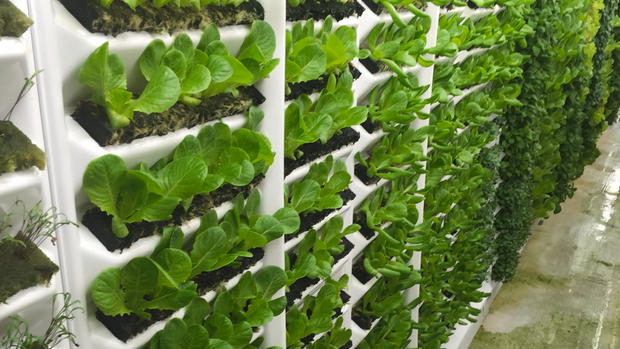WILLMAR—A proposal to grow fresh lettuce and herbs year-round with nothing more than air, light and a fine mist of water and nutrients was presented last month to a local ag-based committee that is more familiar with growing crops in soil.
Aeroponics, which involves growing plants by having roots exposed to oxygen and fed with a mist of water, could be an answer to consumers who want locally grown product and an answer to an entrepreneur looking for a new business, said Dana Anderson, CEO of Living Greens Farms, based in Faribault.
By producing the same amount of leafy green vegetables in one acre of warehouse space that would typically take 200 acres of farmland to produce, aeroponics could also be the answer to land-use sustainability and feeding the world, Anderson said.
He said his system—which holds two patents and has 10 pending—does not use any pesticides and uses 95 percent less water than typically used to grow crops in soil.
“The 21st century farm of the future has arrived,” Anderson said. “We have just an incredible opportunity of improving sustainability and giving consumers a better product.”
He’s now looking to expand the business with a franchise model.
A New London-Spicer graduate, Anderson gave a presentation in August to the agricultural and renewable energy committee of the Kandiyohi County and City of Willmar Economic Development Commission.
The committee’s goal is to identify and develop agriculture, agribusiness and renewable energy opportunities in the county.
Anderson said he started the unique farm in 2014 after several years of doing experiments in his garage.
With a PhD in business administration, Anderson has researched the finances. He said the business of producing leafy green vegetables that are affordable for families is profitable.
Each grow station has an upfront investment of about $50,000, which includes lights, computer, robotic irrigation and climate delivery system, Anderson said. Labor and electrical costs for lighting and temperature control are additional expenses.
Because his system has vertically stacked plant trays instead of flat rows, each station has about 1,000 square feet of grow space sitting on 320 square feet of floor space. He said an empty warehouse could make a perfect location.
Each station can produce the equivalent of one acre of California farmland, Anderson said.
“Farmland in California sells for as much as $70,000 per acre in Salinas Valley,” he said.
Anderson said each grow station can produce a head of lettuce for about 60 cents, including labor and utilities. That cost does not include packaging and delivery. Each station can grow 13 to 17 crops each year.
Anderson said the leafy green vegetable market is a $7 billion industry—and typically about 30 percent of the product is thrown away because of long transportation and storage issues that can cause produce to spoil before it can be sold.
That could be reduced, he said, by growing produce in the same town where it’s used and selling it for the same price charged by out-of-state growers.
“Why would you buy California lettuce when you could grow it right here in Willmar?” he said. “There’s no reason we couldn’t grow it all in Willmar.”
He said owning and operating 10 grow stations would take two to three people to maintain, and it would take two to three years to achieve a payback on the investment.
Interest is “very high” in the product grown at his Faribault facility by local commercial buyers and he said he’s confident selling any produce grown in Willmar would be the easiest part of the process.
Value-added options are also plentiful, he said, like making commercial pesto out of basil or essential oils made from other herbs grown with the aeroponics system.
West Central Tribune by Carolyn Lange

